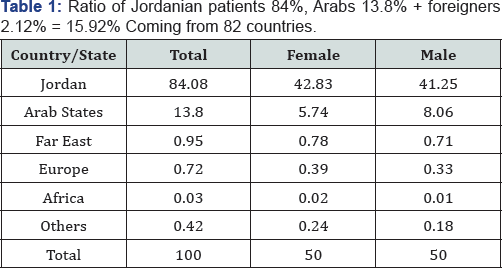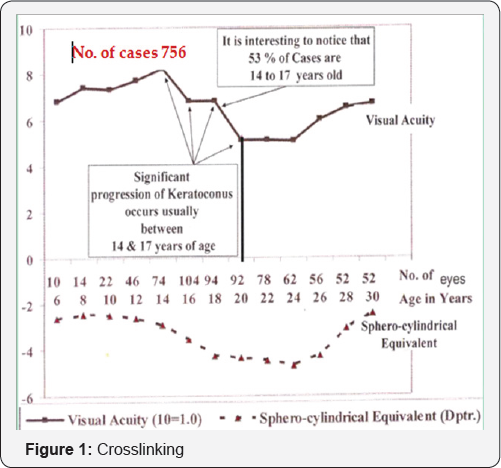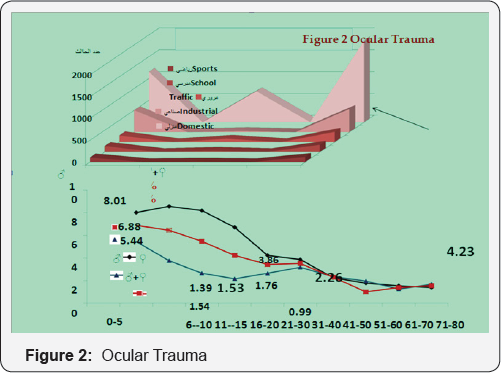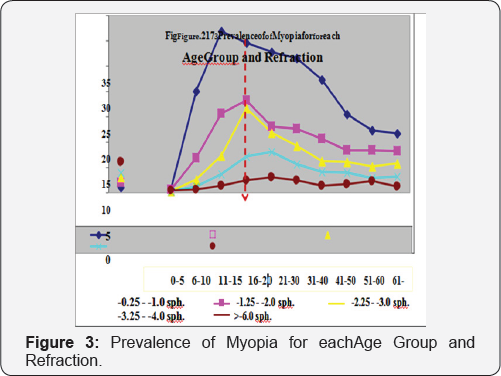The Importance of Computerized Documentation in Medical Sciences Ophthalmology is a Prime Example
Fouad N Sayegh*
Department of Ophthalmology, University of Jordan, Jordan
Submission: June 18, 2017; Published: September 15, 2017
*Corresponding author: Fouad N Sayegh, Department of Ophthalmology, Past Dean, Faculty of Medicine, University of Jordan. 11941 Amman P. O. Box 1885, Jordan, Tel: 00962795524711; Email: prof_fuadsayegh@hotmail.com
How to cite this article: Fouad N S. The Importance of Computerized Documentation in Medical Sciences Ophthalmology is a Prime Example. 2017; 4(4): 555644. DOI:10.19080/JOJO.2017.04.555644
Abstract
Computerized documentation of 54000 consecutive ophthalmic cases was done. It includes programs that perform simultaneously analysis of clinical data each time when new patient's information was added. "Development of Ophthalmology in Jordan” Important information came out that ophthalmologist can't realize within their daily practice and enriched us with ideas for better understanding of systemic diseases as well as indications for community health services, especially the field of prevention of visual impairment and blindness. Some examples are demonstrated.
Introduction
In 1982, I had little idea about the development of Computers Information Systems. Nevertheless, I developed my own documentation program in writing by translating the patients Information and clinical data in numbers. When the new Laptops with their high capacity were developed, this system was implemented and improved 1991 by introducing program that does simultaneous analysis of clinical data when new patient's information was added. Until today, data of 54000 consecutive ophthalmic cases were entered. This presentation includes only few of important information that ophthalmologists will rarely experience within their daily practice.
Materials
The complaints, clinical findings, diagnoses, as well as surgical and medical treatment of 54000 consecutive cases were entered into the computer Riboflavin-
Results
About 16% of all patients came from 82 countries for treatment, Table 1. Some are employees of foreign offices, some are working either as farmers, or in construction and Housekeepers. Most patients came from neighboring Arab countries. It is suggested that outreach programs to be introduced in North Saudi, Yemen and Sudan to establish specializes hospitals that provide high standard, specialized medical services and human resources development. This community service will encourage inter-country cooperation and interaction to facilitate health care in needed areas, improve economy on both sides and support peace process in the Middle East.

Keratoconus
Keratoconus represents 2.28% of examined cases. It is known that if patients show signs of progression at the age of ≥ 20 years, UVA - Cross-linking becomes indicated to prevent further deterioration. Figure 1 show clearly that progression occurs in general between the ages of 10 and 17 years in 53% of the cases, and almost all other cases did not progress after the age of 20 years. Progression after the age of 20 is extremely rare. If the aim of cross linking is to prevent Keratoconus from progression, then it is important this procedure to be applied during the younger ages, at the stage of ocular growth. We know that cross linking destroys the Keratocytes. The question arises, could this procedure affect the growth of the cornea or develop post procedural Keratopathy? Studies have to be done in order to answer this very important situation. Unexpectedly few cases of Keratoconus show improvement of vision and spherocylindrical equivalent at the age of ≥ 24 years.

Ocular Trauma

Ocular trauma independent of age occurs by 5.53% of the cases. The ratio male to female is 2.3:1. The most common trauma is domestic injury 3.5%, 2 followed by industrial 1%, then traffic 0.44% and school with sport traumas together 0.53%, Figure 2. The ratio between rights to left is 1.65:1. It is interesting to notice that children are mostly involved in domestic injuries. 8.01% are five or less "≤ 5" years old and 16.57% ≤ than 10 years of age. Unilateral visual impairment occurs by 7.9% and unilateral blindness by 21.3% of the cases. Community education is very important to prevent visual impairment and blindness caused by domestic injuries.
Refractive Surgery

Myopia recurs after refractive surgery in 14-24% of the cases [1]. Refractive surgery is usually done at the age ≥20 years. Figure 3 shows that myopia of equal or more than "≥-3.25" diopters tends to increase up to the age of 30 years. Persons belong to this category has to be informed about this fact, so that they decide to wait or to take the risk of a possible reenhancement if needed in future.
Aging Disorders

Age related disorders begin at the age of 40 years and increase with These are Diabetes, Hypertension, Ischemic Neuropathy, Cataract, Glaucoma and Age Related Macular Degeneration [2,3]. They are correlated with each other Figure 4. The prevalence of diabetic patients starts to decrease at the age 61-70 years, earlier than other aging disorders. Table 2 shows that the following ischemic diseases, Amaurosis fugax, Aortic aneurysm, Myocardial infarction, Deep vein Thrombosis, Gangrene, Pulmonary Embolism, Renal Failure and Stroke are more common present by diabetics than none diabetics. Insulin treated patients are also more commonly affected by these ischemic diseases than patients receiving alternative medicines. The following Ischemic disorders; "Hypertension, Vascular affected than normal subjects. These complications might be the Obstruction and ischemic Neuropathy”, Table 3, show also that cause of early death of diabetic patients at the age of 61-70 years Table 3 Diabetes is five times more affected, Age related Macular than the other aging disorders 71-80 years.


Investigations at molecular level have shown that all these aging disorders suffer from oxidative stress, Oxidation and Oxidative damage [2,3]. Anti oxidants are therefore applied to prevent further deterioration of very sensitive organs of human body. Prophylaxis on the other side has to be started at earlier, may be at age of 35 years. This matter needs further investigation. I have an Idea to achieve this goal, but needs further investigations. Once this goal is achieved it might be possible to reduce the prevalence of aging disorders, the severity of its complications and prolong age.
References
- Blegvad O (1928) Uber die progression der Myopie. Klin Mbl Augenhk 60: 1955-1981.
- Weinreb RN (2007) Oxidative damage contributes early to glaucomatous optic nerve neuropathy, Cit.Matt MY 48 (10): 45804590.
- Frank RN (1998) Oxidative protector enzymes in the macular layer pigment epithelium of aging eyes and eyes with age related macular degeneration. Trans Am Ophthalmol soc 96: 635-689.






























